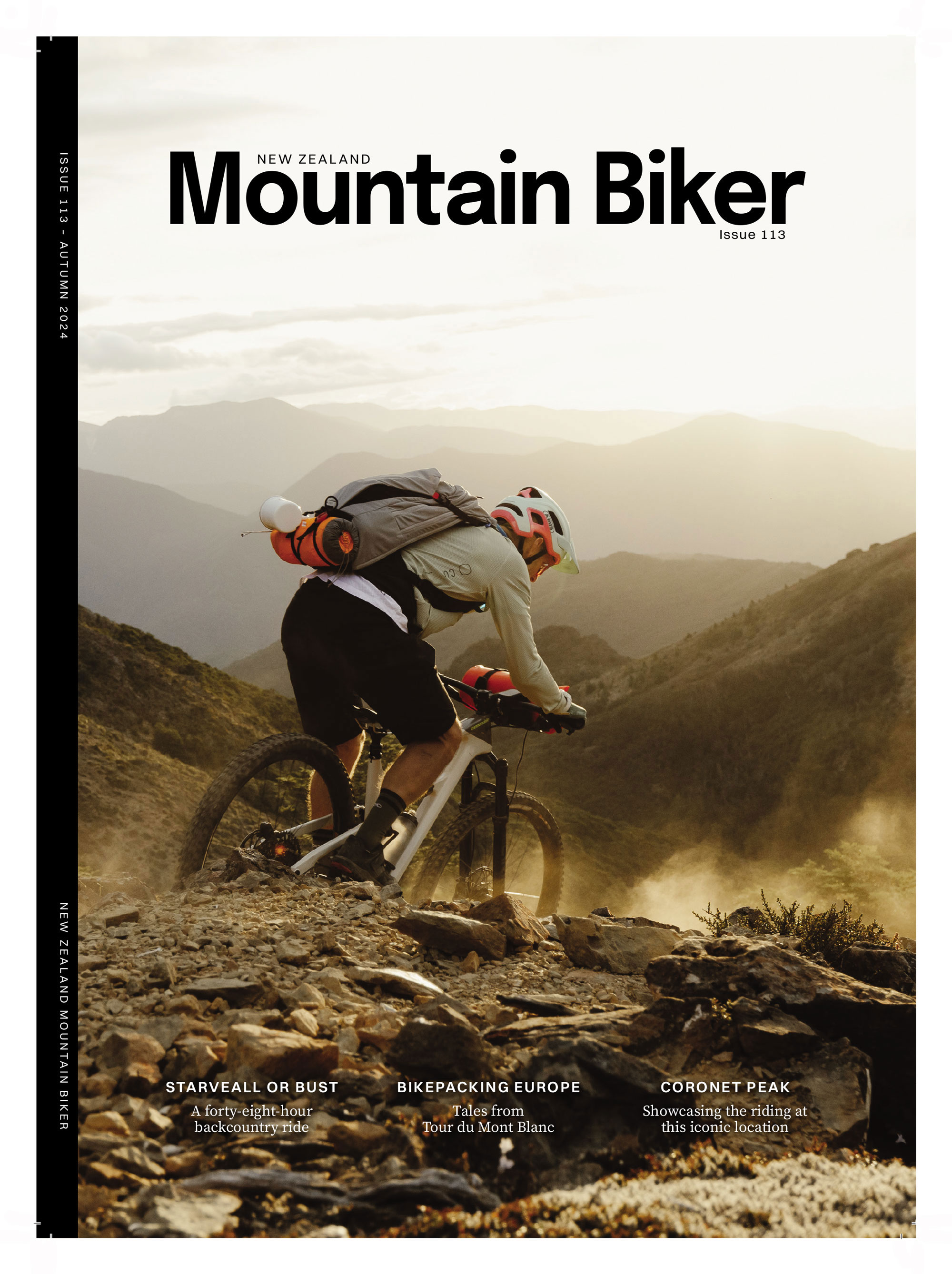Words Lester Perry
Images Henry Jaine
RRP $8699
Distributor Worralls
A summertime fling.
I was sitting at the top of St Arnaud’s ‘What’s Up Doc’ climb; my watch showed 7:30am. It took me an hour and a bit to get here from where I’d camped, and the sun had just peeped over the ranges beside me. Alone aside from the bike, I pondered how many days we still had together, knowing our time together was soon to end.
It wasn’t love at first sight, and although she had some flaws, I’d learned to live with them. Eventually, when the curtains closed on our time together it was tough; this diamond in the rough had left a mark and I didn’t want to part with it.
I was stoked when Cannondale hired a host of creative and stylish riders to form the Waves team, including the unmistakable ’Rat Boy’ Josh Bryceland, to rep their Habit platform. At the time, a short travel trail bike leaning towards a playful style of trail riding. I wasn’t sold on its relatively short travel though; its 130mm in the rear and 140mm front travel left me wanting more. It was just too limiting for my preferred riding spots.
Step forward a few years and in comes the Cannondale Habit LT 1, a longer-legged version of the Habit. The new LT (Long Travel) platform followed on from the Habit, taking its rugged good looks, balanced geometry and all-around fun factor, but in a slightly more forgiving 140mm/150mm package – right up my alley. The LT’s longer travel broadened the type of riding it’s suited to, pushing it toward the rowdier end of the spectrum but without the excess weight and sloth of a full gas enduro bike.
Having spent the bulk of my recent summer months aboard the Habit LT 1, both on my local trails and across a full buffet of South Island holiday road trip adventures, I’ve put this rig well and truly to the test, discovered what I liked and disliked, and ultimately got a good appreciation for what it’s all about.
Before I even set eyes on the bike, I needed to let Cannondale NZ know what size I’d need. According to the Cannondale size chart, at 176cm tall I sit right at the top of the Medium, or bottom of the Large size. What to do? Comparing the geometry of the Medium to that of my own ride I decided it was too short, and the Large was probably larger than ideal, sort of a Goldilocks’ porridge situation. I came to the decision that I’d likely feel cramped on the Medium but could get accustomed to the Large and its 475mm reach. A few weeks later the rig arrived fully built and ready to roll. The Large did feel ‘large’, but not too big; game on!
Clean lines and oversized junctions set the scene for the Habit LT1’s frame. Visually, there’s nothing too out of the box or polarising, although the headtube junction and bottom bracket cluster are pretty substantial. I wouldn’t go so far as to say they’re overbuilt, but those junctions are a noticeable feature of the front end. A full carbon construction, everything other than the suspension linkage is sweet, sweet, carbon fibre, including the chain and seat stays. With no seat stay bridge to be seen, the seat stays are separate, tied together only by the yolk that drives the shock, and the rear wheel axle.
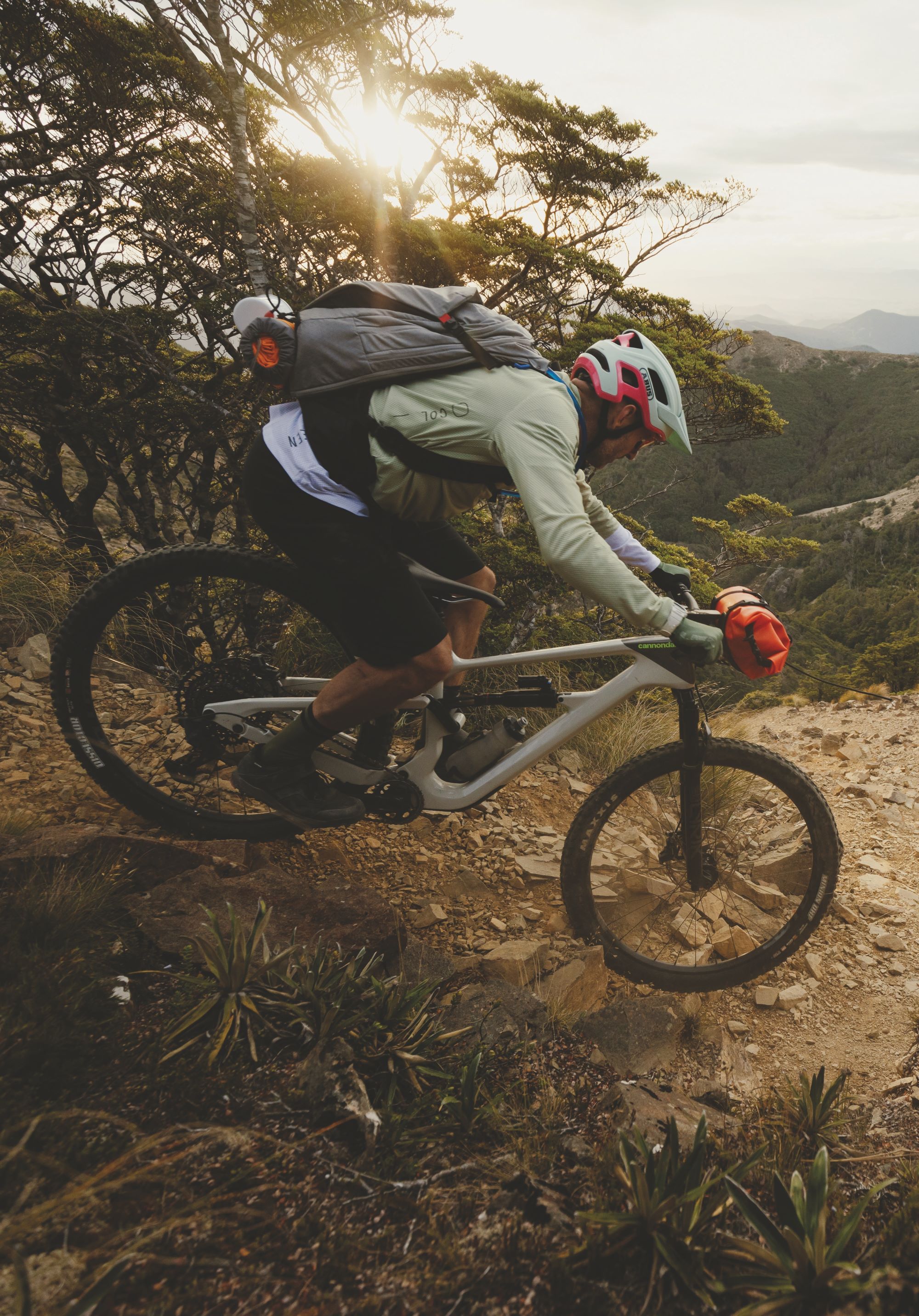
With its comfortable geometry, it’s a bike that you can easily manoeuvre around, or jump over whatever’s in front of you - think a paring knife as opposed to a meat cleaver; they both get a similar result but get there in distinctly different ways.
Cannondale has a somewhat chequered past in some respects, due to regularly adding proprietary technology or features on their bikes, which has ultimately put some riders off making the step onto the brand. It’s great to see nothing too out of the ordinary on the Habit LT line, just industry-standard sort of stuff. A threaded bottom bracket, 148 boost spaced rear end, and regular tub-in-tube internal routing for cables, no niggly headset routing or strange rear wheel offsets on this bike!
Five frame sizes are available, all with 29” wheels, aside from the XS with 27.5” wheels. It’s great to see some size-specific chain stay lengths across the sizes. Small and Medium share the same chain stay length, all other sizes are unique in length. Different length rear ends also mean size-specific rear shock and suspension kinematic tunes, keeping the bike optimised for the rider, however tall they maybe.
The head-angle sits at a conservative but precise 64.7° and the seat tube is an acceptably steep 77.1°(effective). Geometry that’s neither here nor there, but current, and nails the use case for the bike. The main frame has a single bottle cage mount on the downtube, and an accessory mount under the top tube. In the large frame I tested there was heaps of room for a full-size bottle in the front triangle – that’s a win in my book.
Cannondale designers have done a nice job of helping to keep the frame looking fresh long-term, and quiet to ride with well-thought-out rubber protection on the downtube, chain stay and seat stay. Strategically placed top tape keeps other key areas on the frame scuff-free. The addition of a rubber mudguard behind the bottom bracket, over the main pivot, keeps the area contaminant-free and helps with bearing longevity.
Spec-wise, we’re looking at some familiar, tried-and-true hardware on the Habit. A complete SRAM GX Groupset, there’s only one cable and it’s not an electronic one, a complete manual setup here. If you want to upgrade to the latest T-type transmission, there’s a UDH hanger on the frame to allow for that. The GX groupset in this most recent iteration has been around a few years now and it’s a workhorse on a lot of bikes of this level. No complaints here, it just needs the occasional tweak of cable tension, and a clean chain to maintain hassle-free performance.
SRAM’s Code R brakes, with a 203mm rotor up front and a 180mm out back, offer just enough power for this rig. I don’t think I’d manage with anything less on this bike. There’s plenty of adjustment on offer, so even the pickiest of fingers can find the perfect lever position. They’ve got a decent, solid feel at the lever and only on the longest descents I found a little fade in the rear, no doubt exacerbated by my rear-biased braking and that 180mm rotor, a 203 rotor on the back would be ideal.
The bike has a stable, planted feel on the trail, but still feels that there’s enough support to keep it playful and responsive rather than subdued and dull, allowing you to boost from trail features and not feel like you’re blowing through all the travel on landing.
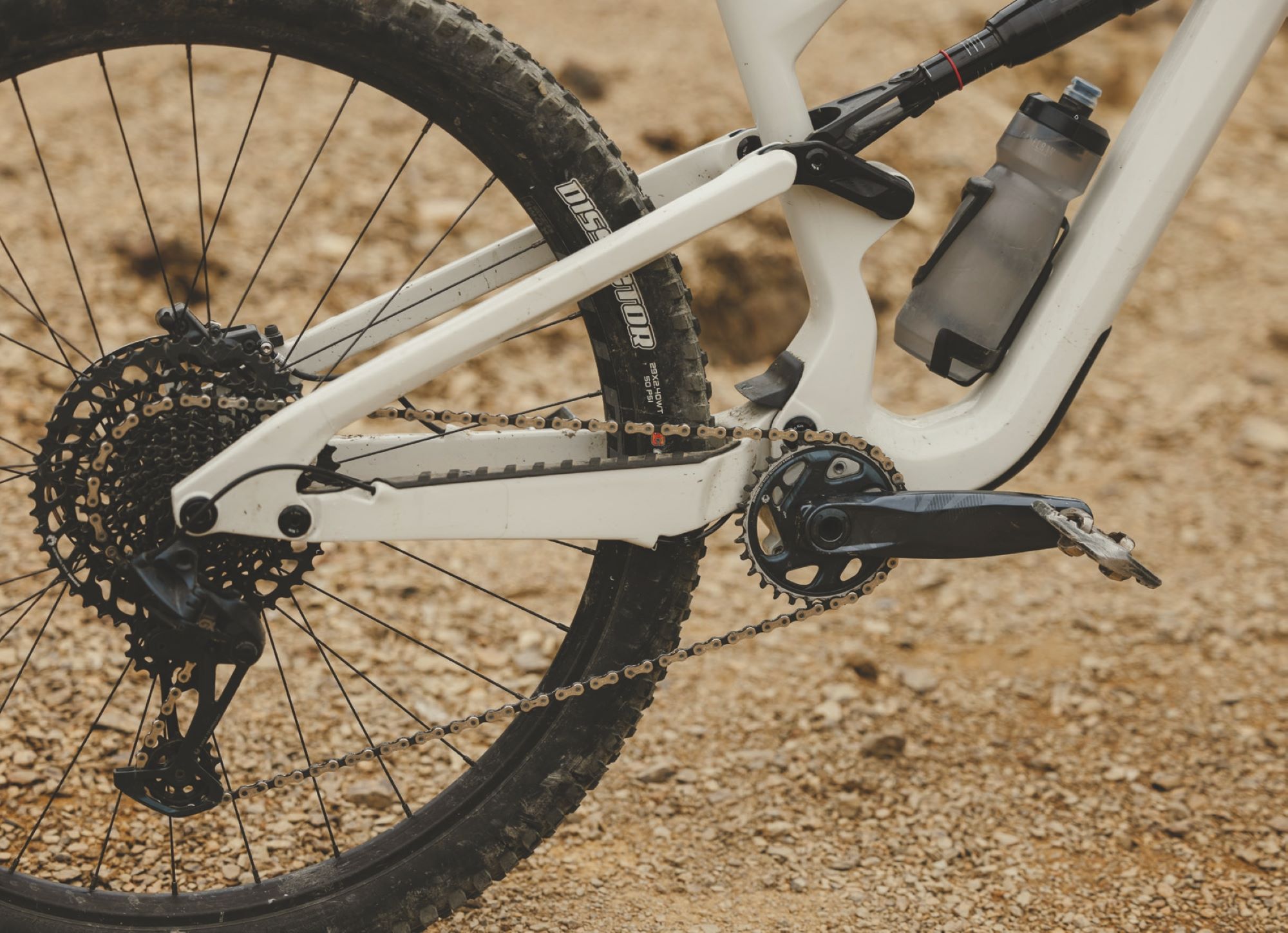
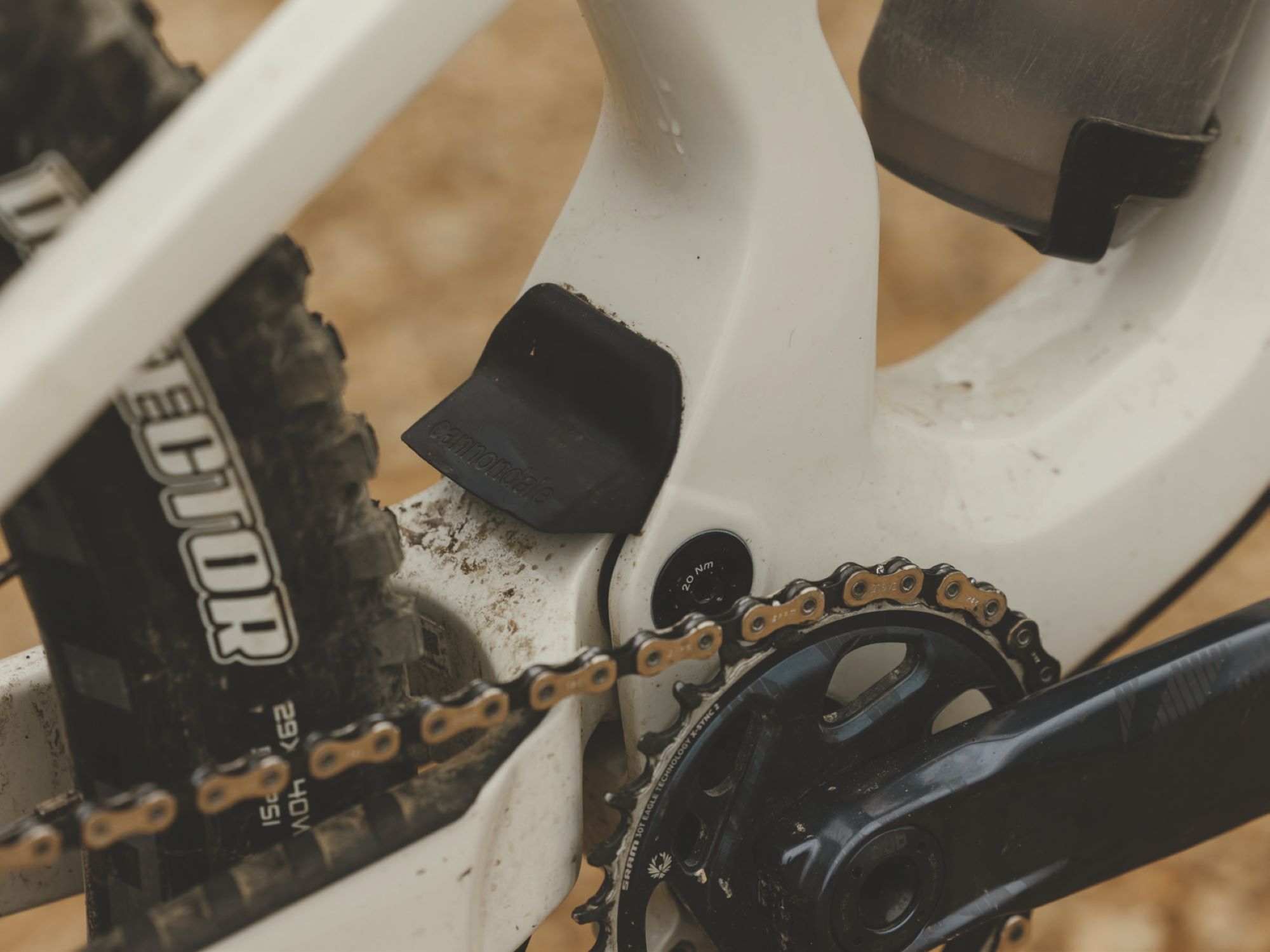
The cockpit and dropper post are taken care of by Cannondale in-house labels, while the grips and saddle are Fabric branded items. The dropper is 170mm and is nice and smooth – not a shotgun fast return but not so slow as to be an issue. The post doesn’t have the lowest stack height, but the length worked ok for me, although with a lower stack post, I’d comfortably go up to around a 190mm drop. Considering I’m right at the bottom of the height recommendation for the Large, I’d imagine the 170mm post won’t be ideal for those more towards the centre or top of the height chart. The seat tube on the Habit LT isn’t the shortest at 445mm, limiting the maximum drop possible on the bike. The dropper lever does its thing with no qualms, and is nice and smooth with a light action.
The HollowGram carbon bar is huge for a trail bike with a 30mm rise, and a full 780mm width – that’s a lot of height for a trail bike, especially one with such a large stack. Riders on the taller end of the spectrum will appreciate this much height, but as you’ll see further on, it was a slight niggle for me. The stem is also a Cannondale in-house number and comes in a nice new-school 40mm length.
The WTB KOM i30 TCS 32-hole wheels on proven DT Swiss 350 hubs have been trouble-free as expected. Not once have I had to pull out the spoke key to remedy a wobble after a cased gap or smashed root. There’s no need to discuss the hubs as it’s fair to say these beauties would see a tonne more riding before I’d even need to look at any bearings. A clean and lube of the freehub may have been necessary, had I been riding in the wet regularly – but over the review period, I touched the mud just a few times.
Shod with a pair of Maxxis tyres, there are no surprises here, or sidesteps needed from the stock spec: a Minion DHF 29×2.5” takes care of tracking up front, while highspeed rolling, but is sketchy in some conditions, with Dissector 29×2.5” features on the rear. It’s good to see Cannondale have the foresight to spec the EXO+ casing version of the tyres, no need for immediate off-the-floor upgrades if you’re an aggressive rider or live in a rocky area where you’ll appreciate the sturdier EXO+ casing over the often specced EXO. The Dissector is an acceptable summer option as a rear tyre, and great in conditions where it can cut in for some traction, but in loose or muddy surfaces it struggles for braking traction (the central knobs are quite low). The side knobs appear to lack support and fold over on the hardpack; great for squaring off berms or flicking a Scandi’ into a turn, but not so much for overall control – wear it out and replace it with a Minion DHR2, problem solved… although a little slower rolling.
Hanging off the front of the chassis is the supple and controlled (thanks to the new Charger 3 TC damper) ROCK SHOX Lyric Select + fork. I’ve been impressed by how good the fork is in all circumstances; high-speed chatter, no matter; big- hitting bangers, no biggie. A bit of experimenting with the high and low-speed compressions left me with the high-speed wide open and two clicks from fully open on the low speed; this seemed a decent setup for most conditions of trails I ride.
The rear end is damped with a ROCK SHOX Super Deluxe Select +. A visit to the ROCKSHOX TrailHead website for some baseline setup advice left me at a few hairs under 30% sag. I subtracted a couple of clicks from recommended on the rebound, speeding the back end up to just how I like it.
For sure I prefer the Habit LT’s active, supple suspension over a higher-anti squat and consequently more ‘locked out’ pedalling experience, particularly at this mid-travel level.
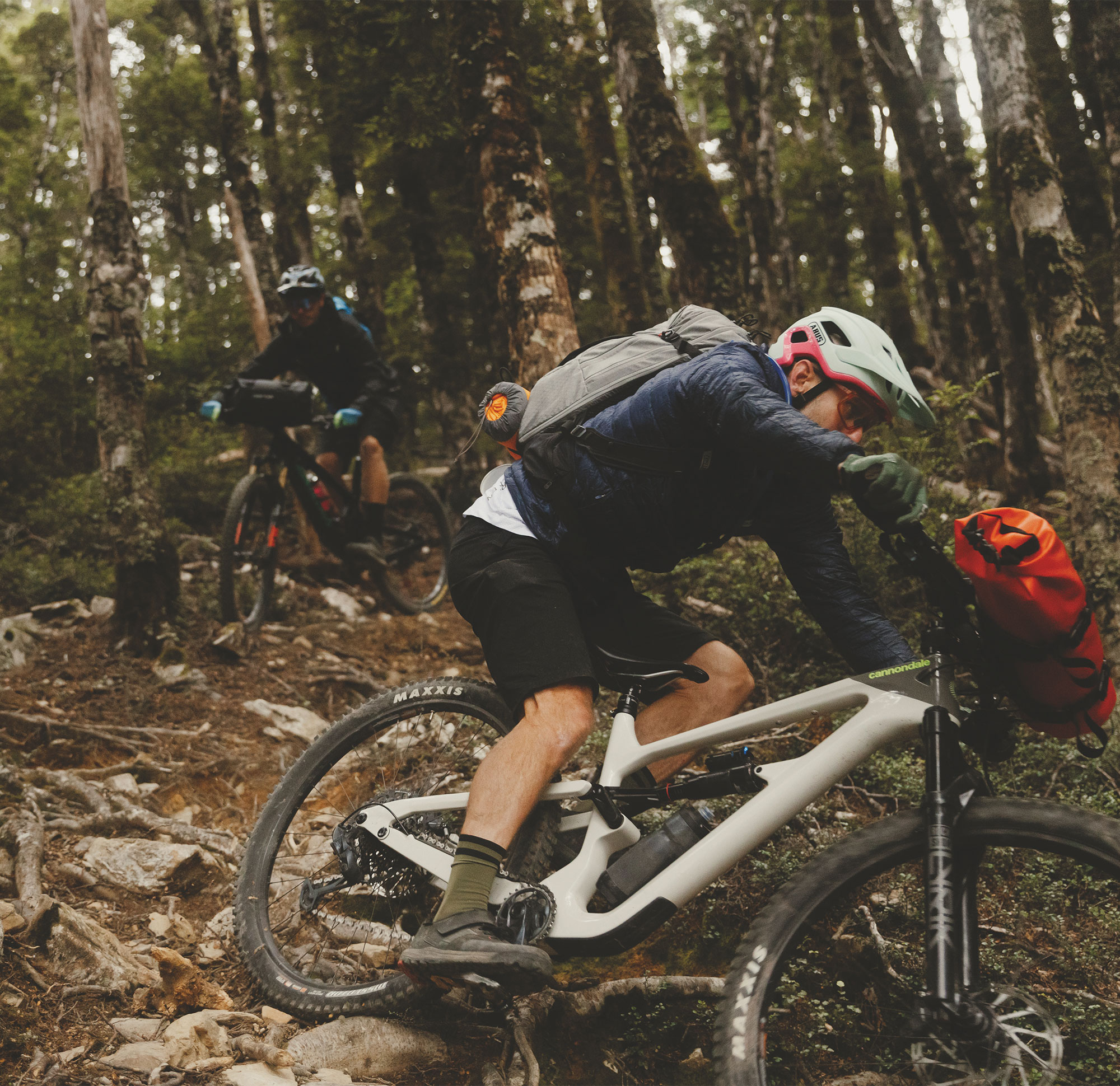
Once the suspension was dialled in, I took the bike for a quick ride and my first impression was that this bike is built for fun: poppy and playful. My second impression is how high the front end is. The large 644mm stack combined with the 30mm rise of the 800mm wide HollowGram SAVE handlebar made it super easy to chuck a sweet wheelie, or manual through a section, but on everything other than steep descents left me feeling disconnected from the front tyre. After some time with my trusty tape-measure, I landed on a 760mm wide, 15mm rise bar and a single 10mm spacer under the stem. Lowering the front made me feel more centred on the bike, with more weight over the front but still keeping the front end high enough for some aggressive riding. Once I got the front end to an acceptable level (for me), it unlocked the cornering of the bike and I felt comfy and at home. Swapping handlebars from new may be needed by some riders, but as bar height and width are certainly a personal preference it likely won’t be necessary for everyone, particularly if you’re on the taller side.
The rear suspension kinematic is linear through most of the travel, feeling consistent through most of the shock stroke and finishing with a steep ramp-up at the end of the travel, preventing harsh bottom-outs. The bike has a stable, planted feel on the trail, but still feels that there’s enough support to keep it playful and responsive rather than subdued and dull, allowing you to boost from trail features and not feel like you’re blowing through all the travel on landing.
Descending on the Habit LT is just plain fun. This isn’t a huge travel rig you can plough un- controlled into chunky rough sections, relying on huge travel and slack geometry to keep you out of trouble. With its comfortable geometry, it’s a bike that you can easily manoeuvre around, or jump over whatever’s in front of you though – think a paring knife as opposed to a meat cleaver; they both get a similar result but get there in distinctly different ways. Central rider weight keeps the bike planted, aiding traction and helping keep you very much under control. Multiple times I exited a trail surprised at how the bike handled some of the rowdier sections, particularly as it hasn’t got the longest travel, or most progressive geometry. On steep trails, with lots of large successive hits, the suspension stiffens up somewhat under the braking forces, causing the back end to feel quite harsh. Not a deal breaker, but more noticeable than some other bikes in this travel range and we’re not really riding that type of terrain often.
Low anti-squat means the rear suspension is still plenty active under pedalling, ideal for a bike aimed at descending fun, rather than pedalling prowess. Of course, this means it’s obviously very active on steep climbs, sagging into its travel and creating bob. I found this quite noticeable and was surprised by just how much it could sink into its travel on really steep uphill pitches. Fear not though; the lockout lever is within easy reach and very effective. I found most of the time I’d throw the lockout on for any extended, consistent climb but leave it open for anything resembling a technical climb as the extra traction it allowed was welcome. For sure I prefer the Habit LT’s active, supple suspension over a higher-anti squat and consequently more ‘locked out’ pedalling experience, particularly at this mid-travel level.
The bike tracks well across off-camber and through flat turns, partly due to the geometry putting rider weight centrally between the wheels, partly due to the supple suspension kinematic, but also because of the back end having a healthy amount of torsional compliance, aka flex. In recent years, designers have been moving away from the aim of having the stiffest bike, aiming for a perfectly tuned flex through the frame. If done effectively, a back end with more flex can also mean better tracking, assisting with overall rider confidence, and feel; I reckon the Habit LT nails this, whether that was the design team’s intention or not. This compliance means the Habit LT isn’t the spriteliest bike while sprinting, but it isn’t a cross-country bike either, so pedalling is secondary to overall roost-ability and fun.
Mellow trails (i.e. most of what we ride) are a blast on this bike; it picks up speed quickly, and jumping into sniper landings or pumping through sections gives a noticeable speed increase.
Cannondale reckons the ‘LT’ moniker stands for Long Travel, but I wonder if it really stands for, as the youth of today say: “Lit Time” (i.e. a “great time” to those of us who are slightly less youthful). Out of the box, as you’ve seen, there were a few things I wasn’t a fan of and, although they’re all personal preferences, they meant I needed to spend precious time getting to my optimal setup, this isn’t exactly a ‘get on and go’ bike. That said, once I got my setup dialled, this bike was awesome. It’s really changed my perspective on what bike I need as my ‘everyday ride’ and, with modern suspension, geometry and frame design, a shorter-travel bike like this can now be on par (or better) than a longer- legged bike from only a few years ago and make for an overall better experience, regardless of the few scenarios it’s not in its element.
